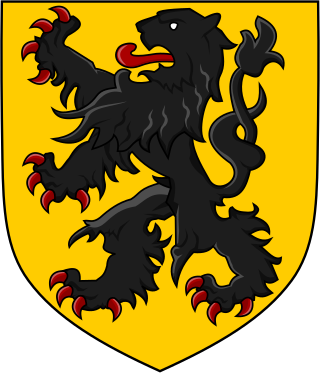Arnulf is a masculine German given name. It is composed of the Germanic elements arn "eagle" and ulf "wolf". The -ulf, -olf suffix was an extremely frequent element in Germanic onomastics and from an early time was perceived as a mere suffix forming given names. Similarly, the suffix -wald, -ald, -old, originally from wald "rule, power" underwent semantic weakening. Therefore, the name Arnulf and Arnold were often conflated in early medieval records, as is the case with bishop Arnulf of Metz, especially as the final consonant came to be dropped (Arnoul).
Eustace I, Count of Boulogne, was a nobleman and founder of the Boulogne branch of the House of Flanders. He held the county of Boulogne from 1024 until his death in 1047.
Baldwin II was the second margrave of Flanders, ruling from 879 to 918. He was nicknamed the Bald (Calvus) after his maternal grandfather, Emperor Charles the Bald.

Arnulf I, called "the Great", was the first Count of Flanders.
Arnulf II was Count of Flanders from 965 until his death.
Baldwin IV, called the Bearded, was the count of Flanders from 987 until his death.

Robert I, known as Robert the Frisian, was count of Flanders from 1071 until his death in 1093. He was a son of Baldwin V, Count of Flanders, and the younger brother of Baldwin VI, Count of Flanders. He usurped the countship after defeating his nephew Arnulf III and his allies, which included King Philip I of France, Count Eustace of Boulogne and the counts of Saint-Pol and Ardres at the Battle of Cassel. He subsequently made peace with Philip, who became his stepson-in-law, but remained hostile to his sister Matilda and her husband William the Conqueror, who was king of England and duke of Normandy.
Arnulf III was Count of Flanders from 1070 until his death at the Battle of Cassel in 1071.
Enguerrand I was the son of Hugh I of Ponthieu and Gisela, daughter of Hugh Capet.
Adele of Vermandois was both a Carolingian as well as a Robertian Frankish noblewoman who was the Countess of Flanders by marriage (934–960).

The March of Ivrea was a large frontier county (march) in the northwest of the medieval Italian kingdom from the late 9th to the early 11th century. Its capital was Ivrea in present-day Piedmont, and it was held by a Burgundian family of margraves called the Anscarids. The march was the primary frontier between Italy and Upper Burgundy and served as a defense against any interference from that state.
The Battle of Cassel was fought in February 1071 between Robert I of Flanders and his nephew, Arnulf III. The battle was a victory for Robert, and Arnulf was killed in the battle.
Arnulf, also known as Arnoud or Arnold, succeeded his father in 988 as Count of Frisia, which by around AD 1100 would come to be referred to as the county of Holland. He was born in 951 in Ghent and because of this he is also known as Arnulf of Ghent. Arnulf was the son of Dirk II, Count of Holland and Hildegard of Flanders. He was named after his maternal grandfather.
Adelolf, Count of Boulogne, was a younger brother of Arnulf I, Count of Flanders and was granted the County of Boulogne by his father.
Arnulf II of Boulogne was Count of Boulogne from 964 to 972. He was the son of Count Adelolf of Boulogne. He succeeded as count in 964 after the death of his uncle Arnulf I, who was also Count of Flanders, and held it until his own death. He is the father of Arnulf III, Count of Boulogne, who succeeded him as Count of Boulogne. He is the ancestor of the Godfrey of Bouillon and Baldwin I, Kings of Jerusalem.

Baldwin II of Boulogne was a son of Arnulf III, Count of Boulogne, whom he succeeded as count of Boulogne.
Adelina of Holland was the daughter of Arnulf, Count of Holland, and Lutgardis of Luxemburg. She married firstly Baldwin II, Count of Boulogne, and secondly Enguerrand I of Ponthieu.

The House of Flanders, also called the Baldwins, was a medieval ruling family of Frankish origin that was founded by Baldwin Iron Arm, son-in-law of Charles the Bald. The House of Flanders was the first dynasty to transform a county function of the Carolingian Empire into a hereditary fiefdom, the County of Flanders, falling under West Francia, created by the Treaty of Verdun in 843.

Count of Boulogne was a historical title in the Kingdom of France. The city of Boulogne-sur-Mer became the centre of the county of Boulogne during the ninth century. Little is known of the early counts, but the first holder of the title is recorded in the 11th century.




